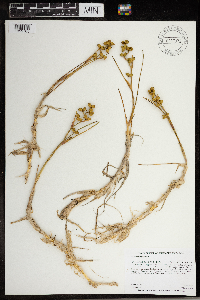Scheuchzeria palustris
|
|
|
|
Family: Scheuchzeriaceae
Rannoch-Rush
|
Herbs, glabrous. Rhizomes creeping, jointed, freely branching. Stems flexuous, zigzag, 1--4 dm. Leaves striate; cauline leaves gradually reduced to bracts; sheaths 1.5--10 cm, ligules 2--12 mm; hairs within leaf sheath 0.2--2 cm; blade 2--41 cm × 1--3 mm. Inflorescences 3--12-flowered, 3--10 cm; proximal bract foliaceous; distalmost sheaths sometimes bladeless; pedicels spreading, 5--25 mm. Flowers: tepals in 2 similar series of 3 each, white to yellow-green, lance-ovate to lanceolate, 1-veined, 2--3 mm, membranous, apex acute; filaments filiform; anthers linear, elongate; pistils 6--7 mm; styles oblong; stigmas papillose. Follicles light green to brown, ovoid, 4--10 mm, leathery, dehiscing on curved, adaxial side; beak 0.5--1 mm. Seeds brown to black, ovoid, 4--5 mm, smooth, hard; endosperm absent. 2n = 22. Flowering in late spring. Sphagnum bogs, marshes, and lake margins; 0--2000 m; Alta., B.C., Man., N.B., Nfld. and Labr., N.W.T., N.S., Ont., Que., Sask., Yukon; Alaska, Calif., Conn., Idaho, Ill., Ind., Iowa, Maine, Mass., Mich., Minn., Mont., N.H., N.J., N.Y., N.Dak., Ohio, Oreg., Pa., R.I., Vt., Wash., W.Va., Wis.; Eurasia. North American representatives of this species have been regarded as being varietally distinct from Eurasian plants on the basis of follicle and stigma characters (M. L. Fernald 1923). Variability in those characters, in specimens from both hemispheres, vitiates their worth for varietal distinction.
Perennial emergent aquatic to 40 cm tall Stem: upright, unbranched, slightly zigzagging, with numerous intravaginal hairs at the nodes. Leaves: growing basally and along the stem, upright, alternate, stalkless, 5 - 30 cm long, 1 - 3 mm wide, linear to nearly cylindrical, with an evident round pore on the inner side at the tip. Leaves have conspicuously expanded sheaths and prominent ligules (an appendage at the leaf base). Flowers: in a terminal inflorescence. Tepals six (in two series of three), white to yellowish green, 2 - 3 mm long, lance-shaped. Stamens six, with linear anthers. Fruit: a recurved follicle (a dry, dehiscent fruit opening along a single side), light green to brown, 4 - 10 mm long, egg-shaped, leathery. Similar species: Scheuchzeria palustris is the only representative of the family Scheuchzeriaceae in the Chicago Region. The round pore at the tip of the leaves will distinguish it from similar-looking plants. Flowering: May to July Habitat and ecology: Very rare in the Chicago Region, occurring in Sphagnum bogs. Occurence in the Chicago region: native Etymology: Palustris means marsh-loving. Author: The Morton Arboretum Stems 2-4 dm; lvs with conspicuously dilated sheath, the basal ones clustered, the cauline 1-3, well separated; lf-blades erect, 5-30 cm נ1-3 mm; racemes 3-10 cm, the lowest bract foliaceous, the second with small or no blade, the others reduced to small sheaths; tep lance-ovate, 2-3 mm; fr 6-8 mm; 2n=22. Cold Sphagnum-bogs; circumboreal, in Amer. s. to N.J., Pa., Ind., Io., and Calif. Late spring. Gleason, Henry A. & Cronquist, Arthur J. 1991. Manual of vascular plants of northeastern United States and adjacent Canada. lxxv + 910 pp. ©The New York Botanical Garden. All rights reserved. Used by permission. From Flora of Indiana (1940) by Charles C. Deam Very local in some of the counties of the lake area. I have it only from two counties but it has been reported also from Cass, Fulton, Lake, Marshall, Porter, and St. Joseph Counties. It is usually found in sphagnum with pitcherplant and cranberry. …… Indiana Coefficient of Conservatism: C = 10 Wetland Indicator Status: OBL |





































































